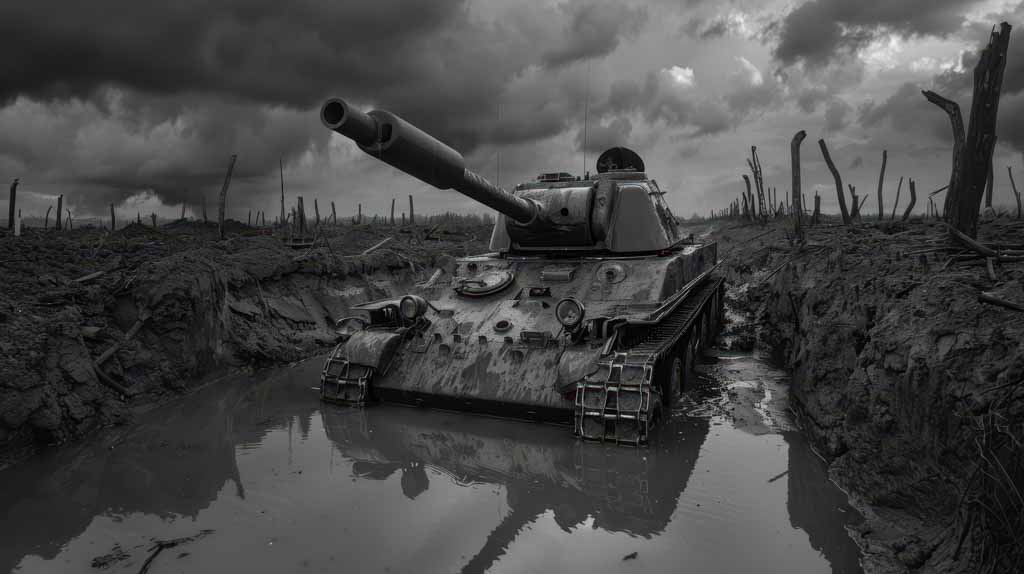Impenetrable peat bogs are good for defence and the climate

Let vast peatlands on Europe’s eastern borders become waterlogged, write Philipp Gramlich and Karin Bodewits. Because tanks drive poorly in the mud.
This is an unofficial translation by Stichting Turfvrij. The original article was published in Trouw, May 22nd 2025.
What stopped Russia from taking Kyiv in 2022? Ukraine, under Russian attack since 2014, was prepared. Advanced weapons systems played a crucial role, but an unexpected ally proved just as important: the wet, impenetrable peatlands north of Kyiv. Tanks drive poorly in mud. The tragic and recent incident in which four American soldiers died in a Lithuanian swamp during a military exercise underscores the deadly challenges of such terrain.
The Russians were forced to rely on narrow main roads, their tanks in a single column – an ideal target for Ukrainian defenders. But what if such natural obstacles are lacking? Peatlands have been largely drained in the Baltic States, a potential next target for Russian aggression. Once drained for agriculture or peat extraction, they now offer little resistance. As the largest importer of peat for potting soil in Europe, the Netherlands has a direct interest in this. Moreover, many of these peatlands are in Dutch hands, which means that we as a country also bear responsibility for how they are managed.
The recovery of living peat takes years, but creating a defensive mud barrier – a wet defence – can be done quickly, by closing drainage ditches and switching off pumps. The peat then soaks up rainwater and becomes impenetrable mud. Targeted flooding, as happened around Kyiv, can accelerate this. This approach, also known as warWilding, offers an opportunity to strengthen the eastern borders of Europe.
Water for defence is not new
The idea of using water as a means of defence is not new. As early as the 17th century, the Netherlands used the Dutch Waterline: a controlled flooding system that transformed entire regions into an impenetrable water barrier. Enemy armies were stranded in a vast swamp where only small boats could sail. Ships or large transports could not get any further. The same principle can now be applied in the eastern border regions of Europe: a modern European Waterline.
The discussion about defending Europe’s eastern border is dominated by rearmament and the recruitment of more soldiers. Active restoration or reinforcement of natural barriers remains underdiscussed. Only one policy paper, from the Greifswald Moor Centre, advocates wetting peatlands as a defence strategy.
That is a missed opportunity. Closing drainage ditches is cheap. The biggest hurdle is for landowners who lose their agricultural income. Here, the European defence budget offers a solution: compensation for lost agricultural yields, supplemented with income from carbon credits. Drained peat emits between 15 and 40 tons of CO2 per hectare per year. Raising the water level stops these emissions almost immediately.
Farmers can switch to wet agriculture
In the long term, farmers can switch to paludiculture or wet agriculture, a concept promoted by Dutch professor Hans Joosten. Europe can support this transition with subsidies and guarantees.
Europe needs weapons for its defence. However, a massive military build-up always carries the risk of escalation or even threatens to become the cause of a conflict. The wet defence strategy, on the other hand, is purely defensive and non-escalating. No Russian propagandist can present this muddy barrier as an offensive threat.
The countries on Europe’s eastern borders face an existential threat, but they are not the only targets – the whole of Europe is under pressure. That is why we must explore all possible ways to protect these border countries. Wet defence is a cheap, non-escalating defence method that can strengthen Europe immediately.
It is up to the Netherlands, as the largest buyer of peat and a major European player, to actively promote this idea. European politicians must support the restoration of peatlands along the eastern borders. Let us not stand by and watch Russian tanks roll unhindered over drained peatlands – drained for the hydrangea on our windowsill – when we could have easily prevented this.